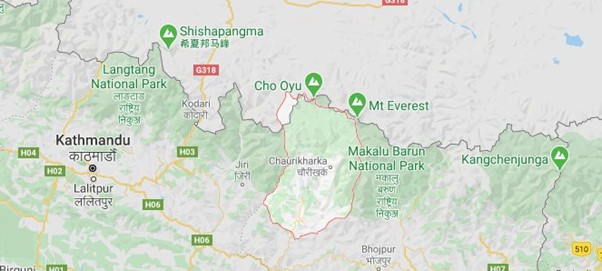The name ‘Sherpa’ in mountaineering prowess lore globally is as world-renowned as that of ‘Gurkha’ in military prowess lore across the UK, India, the World.
The mystical fabled lands of the highest Himalaya, with Sagarmatha [Mt Everest] in particular, form the lands of birth of the Sherpa people, whose homelands focus in particular [there are other Sherpa peoples lands along parts of Nepal’s frontier with Tibet] on the Solu Khumbu region with at its heart Sagarmatha, better known internationally as Mt Everest, and with its name in the Sherpa language being Chomolungma (in Tibetan, Quomolungma). The Sherpa people (in their own language, Sherpa, literally ‘Sher’ [east] ‘pa’ [people]) are in fact migrants from Kham in Tibet, and came to settle in Solu Khumbu and other regions and districts in Himalayan Nepal, Bhutan, Sikkim, Nth Western Bengal and beyond, around and after the 1400s (CE).
There were four main clans (just as there are a number of those with the Gorkha peoples: Gurung, Rai, Tamang, Limbu, etc. whose names recur frequently in military service and other domains) of Sherpa People at the time the Sherpas migrated from Kham in Tibet to Solu Khumbu and other areas of Himalayan Nepal some 600+ years ago, and subsequently developed some 20+ sub-group clans.
You can read more about the Sherpa people’s history and geographical distribution at https://en.wikipedia.org/wiki/Sherpa_people

The terrain and certainly the weather have and continue to shape the culture of the Sherpa people, influencing everything for foods to sacred and other festivals, and certainly traditional forms of livelihood and employment which for many have increasingly over the past fifty years included the mountaineering supportive local economy, key to employment generation. ‘THE’ Mountain (Mt Everest) has obscured for many (but far from all) overseas travellers to Solu-Khumbu and Mt Everest the opportunity to learn about the very ancient culture of the Sherpa people. This section of the information resource in some modest way tackles this.
Traditionally for all, and still for many, daily life of the Sherpa people has been dominated by pastoral animal husbandry and agriculture, each of these in turn influenced by the seasons and of course the ever present raw power of extreme altitudes. Alongside these major land linked daily life influences, trade has traditionally been of comparable importance, and with it of course artisanship linked to both functional needs, building, storage of foodstuffs, and social occasions, and ancient religious and spiritual cultures.
For the Sherpa People as with other Burmo-Tibetan peoples born and living in the Himalaya, the mountains and especially mountain summits, hidden valleys (epitomised by the myth and legend of ‘Shangri La’) and caves of the high places, are scared, extraordinary places of awe, inspiration and reverence. However, the intrusion of plastic culture and hordes of mountaineers from all over the world have brought major shifts in socio-economic life and most of all the life of the people, and the natural environment.
The effects of mountaineering, especially the lure of ‘conquering the highest mountain in the world, Sagarmatha (Mt Everest)’ has however had as great an impact for Solum Khumbu and the Sherpa people as at turns a major plague, and a ‘gold rush.’
